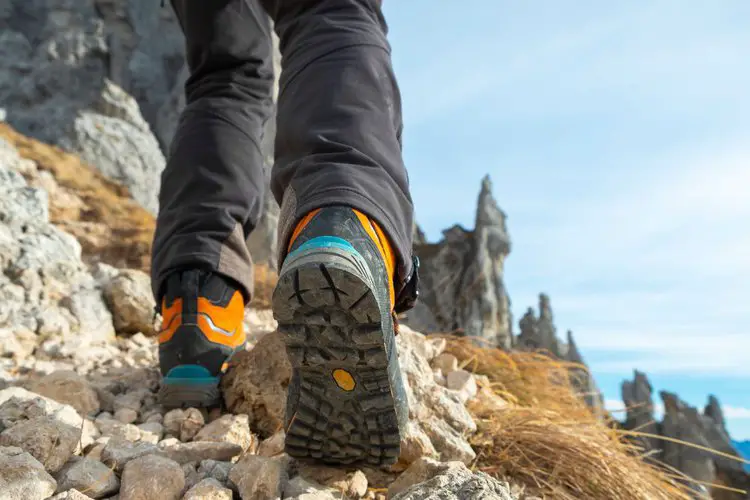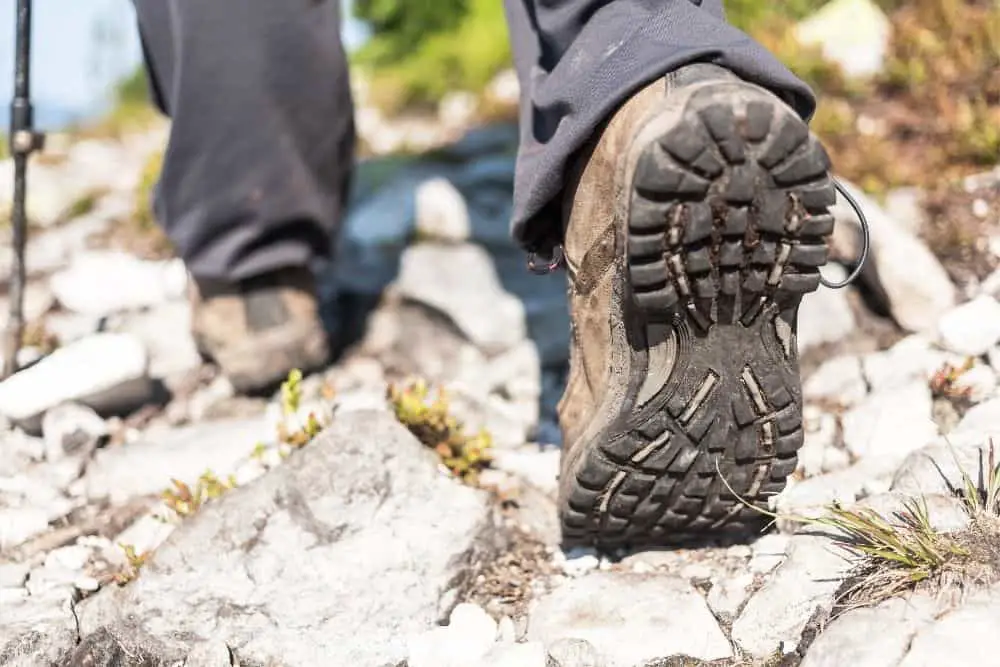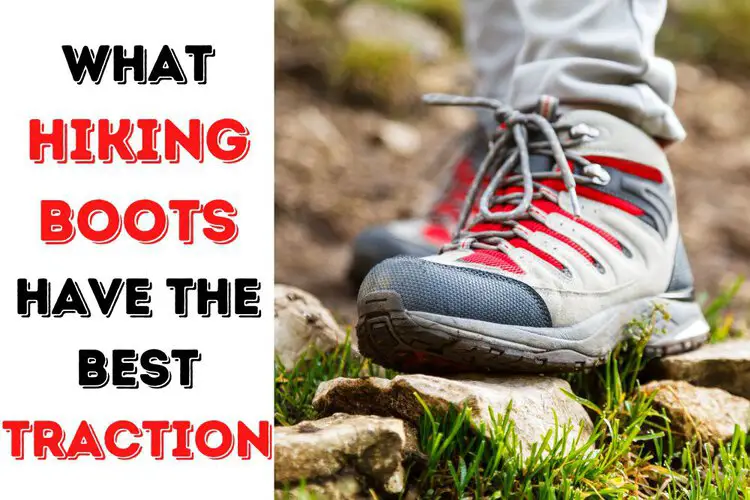Hiking is an enjoyable and rewarding activity, but having the right gear is essential for a safe and comfortable experience. One of the most important pieces of gear for any hiker is a good pair of hiking boots.
Hiking boots serve several purposes, from providing support for your feet to keeping you stable on rocky terrain. But what sets some hiking boots apart from others is their level of traction.
With great traction, hiking boots provide a number of benefits to help you tackle any terrain with confidence.

First and foremost, they help prevent slips and falls, which can be particularly important on wet or slippery terrain. With a better grip on the ground, you’ll be able to maintain your balance and stability, even on challenging surfaces.
In addition, hiking boots with good grip will provide better stability and reduce the strain on your ankles and feet. Thus, they can prevent injuries from occurring.
Another benefit of hiking boots with good traction is that they help improve your overall hiking experience.
With a better grip on the ground, you’ll be able to hike with more confidence, knowing that you’re less likely to slip and fall. This can make your hike more enjoyable, and allow you to focus on the beauty of the landscape rather than worrying about your footing.
Finally, hiking boots with good traction are essential for tackling challenging terrains, such as steep inclines, rocky paths, and muddy trails.
With a good grip, you’ll be able to make your way up steep inclines and navigate rocky paths with ease. And with better traction on wet or muddy trails, you can stay stable even on the wettest of days.
Contents
How many types of hiking boots are there and how are their traction levels different?
There are several types of hiking boots to choose from, each designed to meet specific needs.
Light hiking boots are perfect for day hikes or light backpacking trips, while backpacking boots are designed for multi-day backpacking trips.
On the other hand, mountaineering boots are made for high-altitude mountaineering, where the terrain is especially rugged and the weather can be harsh.
When it comes to traction, all hiking boots will have some level of grip, but the level of traction can vary greatly depending on the type of hiking boot.
The level of traction is determined by the outsole, which is the bottom of the boot that comes into contact with the ground. It plays a crucial role in providing grip and stability on different types of terrain.
The type of outsole material used and its design can greatly impact the level of traction. A good hiking boot outsole should provide a good grip on wet and dry surfaces, as well as offer enough traction on slippery or uneven surfaces to prevent slips and falls.

For example, rubber is a common material used in hiking boot outsoles. It’s durable and provides good traction on dry surfaces.
Some hiking boots use a specialized type of rubber, such as Vibram, which offers a better grip on wet and slippery surfaces.

Another factor that affects the level of traction is the design of the outsole.
Hiking boot outsoles can have a variety of designs, such as lugs, which are small protrusions that help provide grip on the ground.
Some hiking boots have a multi-directional lug pattern, which provides better traction in various directions.

The depth and spacing of the lugs can also contribute to the grip of hiking boots. Deeper lugs provide better traction on soft or muddy terrain, while wider-spaced lugs are better for hard, dry terrain.
Besides, waterproof hiking boots can provide better traction in wet conditions because they help prevent slippage inside the boots.
When your feet get wet, it will be quite slippery inside the boots, reducing your grip and stability. Waterproof hiking boots help keep your feet dry, reducing the risk of slippage.
Additionally, many waterproof hiking boots use waterproof materials in the upper part. This helps prevent water from entering the boot and keeps your feet dry and less slippery inside the boots.
Another factor to consider with waterproof hiking boots is that they often have a Gore-Tex or similar waterproof membrane that helps keep water out while still allowing your feet to breathe. This is important because if your feet get too hot and sweaty, they can also slip inside the boot, reducing traction.
What hiking boots should you choose for the best traction?
Light hiking boots typically have a rubber outsole that provides good traction on dry, rocky terrain. They’re not designed for heavy-duty use, but are perfect for day hikes or light backpacking trips.

The next choice is backpacking boots. This type of boot will have a more aggressive outsole, which grips better on wet and slippery surfaces. They’re also better for more rugged terrain, where good traction is essential.

Compared to light hiking boots, backpacking boots also tend to be heavier and more supportive, making them suitable for multi-day backpacking trips.
The last candidate is mountaineering boots. They are designed for extreme conditions, so they’ll have the most aggressive outsole of all hiking boots.


They provide excellent traction on ice, snow, and other slippery surfaces, making them the best choice for high-altitude mountaineering.
Overall, mountaineering boots are the heaviest and most supportive of all hiking boots, but they’re also the most expensive.
Here’s a quick note for you!
When choosing a pair of hiking boots, it’s important to consider the type of terrain you’ll be hiking on and the conditions you’ll encounter.
Some tips to choose the best hiking boots with great traction for each terrain
Here are some tips on how to choose hiking boots with the best traction for different types of terrain or environment:
- Wet Terrain: For hiking on wet terrains such as mud, rain, or snow, you’ll want hiking boots with a sticky rubber outsole that provides a good grip on slippery surfaces. Look for hiking boots with a deep tread pattern and aggressive lugs, which will help prevent slipping and keep you stable on wet terrain.
- Rocky Terrain: For hiking on rocky terrain, you’ll need hiking boots with a stiff sole and good underfoot protection. Choose one with a Vibram sole and a rubber rand. A Vibram or similar sole should be a great choice to provide a good grip and stability on rocks. While a rubber rand that wraps around the boot and protects your feet from rocks and other sharp objects.
- Technical Terrain: For hiking on technical terrain with steep inclines, exposed scrambles, and narrow ledges, hiking boots should have good support, stability, and grip. Your ideal choice is one with a stiff sole, a high ankle, and a rubber rand.
- Gravel Terrain: For hiking on gravel or loose rock terrain, hiking boots with a sole that provides good grip and stability on loose surfaces are essential. You should pick ones with a sticky rubber outsole, a deep tread pattern, and aggressive lugs.
- Mixed Terrain: For hiking on a mixture of different types of terrain, you’ll want hiking boots that provide good all-around traction and stability. Hiking boots with a sticky rubber outsole, a deep tread pattern, aggressive lugs, and a stiff sole come into play.

When trying on hiking boots, it’s also a good idea to test them for traction by walking on different surfaces, both inside and outside the store.
This will help you get a sense of how the boots will perform on different types of terrain. Thereby, you can make an informed decision about which boots are right for you.
It’s also important to remember that hiking boots should fit properly, with enough room in the toe box to wiggle your toes, but with a snug fit around your heel and ankle to provide support and stability.
A good fit is key to getting the best traction from your hiking boots, so be sure to try on several different sizes and styles to find the right fit for you.
Last words
In conclusion, choosing the right hiking boots with good traction is essential for a safe and enjoyable hiking experience.
Consider the type of terrain you’ll be hiking on, the conditions you’ll encounter, and your level of experience before choosing a pair of boots.
With the right hiking boots, you can tackle any trail with confidence and enjoy your hike fully!



